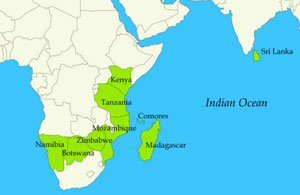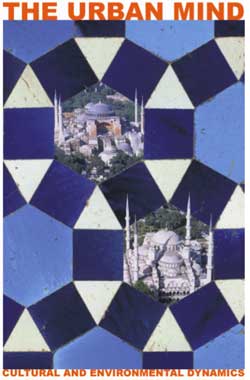SWEDISH SOUTH ASIAN STUDIES NETWORK
Department of Archaeology and Ancient History, Uppsala University:
Address: S:t Eriks Torg 5 , SE-753 10 Uppsala
Web page: http://www.arkeologi.uu.se/
Contact person: Professor Paul Sinclair, Director of studies, postgraduate level, phone: +46 (0)18 471 20 95
 Paul Sinclair is Professor of African Archaeology, and has been particularly interested in evidence based spatial analysis of material culture distributions in regional and
landscape perspectives. He has worked on socio-environmental interactions in farming community and
urban contexts in the central African and Indian Ocean regions. The complexity of linear and non-linear
processes operating in multi-scalar contexts underline the need for joint research teams and therefore he has been
engaged in comparative work in Mozambique, Madagascar and Sri Lanka. Prof. Sinclair has also been involved in re-thinking the
role of Africa in the Indian Ocean trading networks resulting from the recent identification of 1st millennium
BC Harappan and early Buddhist ceramics on the coast of East Africa. 400 dated sites from the
last 12 000 years are viewed in time series in relation to soils and vegetation covers and provide a comparative
basis for comparison with similar data from the Amazon region and from South East Asia.
Paul Sinclair is Professor of African Archaeology, and has been particularly interested in evidence based spatial analysis of material culture distributions in regional and
landscape perspectives. He has worked on socio-environmental interactions in farming community and
urban contexts in the central African and Indian Ocean regions. The complexity of linear and non-linear
processes operating in multi-scalar contexts underline the need for joint research teams and therefore he has been
engaged in comparative work in Mozambique, Madagascar and Sri Lanka. Prof. Sinclair has also been involved in re-thinking the
role of Africa in the Indian Ocean trading networks resulting from the recent identification of 1st millennium
BC Harappan and early Buddhist ceramics on the coast of East Africa. 400 dated sites from the
last 12 000 years are viewed in time series in relation to soils and vegetation covers and provide a comparative
basis for comparison with similar data from the Amazon region and from South East Asia.
Research project in Sri Lanka
From the beginning of the 1990s, the unit for African and Comparative Archaeology at the
Dept. of Archaeology and
Ancient History in Uppsala cooperated with the Post-Graduate
Institute of Archaeological Research (PGIAR), at the University
of Kelaniya, Sri Lanka. A bilateral SAREC supported research project
called ”The Archaeology of Southern Sri Lanka”, was initiated
in 1994, which was part of the larger worldwide HRAC
project (Human Responses and Contributions to Environmental Change that was running during the period 1994–1997).
Prof. Paul Sinclair was the director/coordinator for the project.
The Dept.
of Physical Geography and Quaternary Geology at Stockholm University
was also involved in the project.
The research themes were:
1. Paleo environment and climate change
2. Settlement systems and environmental change
3 Long term food procurement and resource utilization strategiesThe PGIAR team for the Archaeology of Southern Region Project has consisted of the following seven Sri Lankan researchers (out of which the first three were registered as PhD candidates at Uppsala University):
• T.R. Premathilake, M.Sc (Sri J'pura), Lecturer Palaeo Environment
• Raj Somadeva, M.Phil (PGIAR) Senior Lecturer Urbanization, Epigraphy and Archaeological theory
• Gamini Adikari, M.A (PGIAR), Lecturer Pre-History, Stone tool technology and Osteology
• Jagath Weerasinghe, MFA ; Senior Lecturer Archaeological theory and history, Materials and Technology and Art History
• Rose Solangaarachchi, M.A (PGIAR), Lecturer Metallurgy
• Priyantha Karunaratne, M.A (Arizona), Lecturer Settlement Archaeology, Proto and Early History and Field Archaeology
• Arjuna Thantilage, M.Sc in Analytical Chemistry, (Colombo), Lecturer Palaeo Dietary Reconstruction
Dr. T. R. Premathilake defended his doctoral thesis on ”Late Quaternary Palaeoecological Event Stratigraphy in the Horton Plains, Central Sri Lanka with contributions to the Recent Pollen Flora” at the Dept of Quaternary Research, Stockholm University on 4 June 2003. More information.
 Dr. Raj
Somadeva (photo to the right) defended his doctoral
thesis on ”Urban Origins in Southern
Sri Lanka” on Wednesday 25 January 2006.
The study focuses upon the development of urbanisation in southern
Sri Lanka during the proto, early and late historical periods c.
900 BC onwards, and confirms the Dipavamsa and Mahavamsa historical
chronicles compiled c.400-500 A.D in showing that the southern semi-arid
zones of Sri Lanka have maintained a distinct socio-political character
throughout Sri Lankan history. Faculty opponent was Dr Sunil
Gupta, Director for the Indian Ocean Research Centre in New Delhi,
India. More
information with abstract.
Dr. Raj
Somadeva (photo to the right) defended his doctoral
thesis on ”Urban Origins in Southern
Sri Lanka” on Wednesday 25 January 2006.
The study focuses upon the development of urbanisation in southern
Sri Lanka during the proto, early and late historical periods c.
900 BC onwards, and confirms the Dipavamsa and Mahavamsa historical
chronicles compiled c.400-500 A.D in showing that the southern semi-arid
zones of Sri Lanka have maintained a distinct socio-political character
throughout Sri Lankan history. Faculty opponent was Dr Sunil
Gupta, Director for the Indian Ocean Research Centre in New Delhi,
India. More
information with abstract.
The Swedish researchers were formally involved in the project functions as PhD supervisors or trainers for the PGIAR researchers. Prof. Paul Sinclair supervised the PGIAR researchers who were registered in Uppsala (Somadeva, Thantilage and Adikari), whereas Prof. Urve Miller and Dr. Jan Risberg of the Department of Quaternary Research, Stockholm University supervised the paleo-environmental work of Premathilake. Gamini Adikari, working on marine resource exploitation, also received supervision in specialised biological theory and osteological applications by Prof. Jan Ekman of the Dept. of Evolutionary Biology, Uppsala University.
In August 2003, the Dept. of Archaeology and Ancient History organized a Symposium on ”Urban Landscape Dynamics and Resource Use”. The symposium, co-organized by the Collegium for Development Studies (CDS) at Uppsala University, aimed at synthesizing and formulating a proposal on ”Urban Landscape Dynamics: a Framework for South-South-South co-operation” to be put for consideration by the Swedish Agency for Research Cooperation with Developing Countries (SAREC) research committee by 30th October 2003. This was a follow-up to a decision by Sida/SAREC’s board in September 2001 to support the idea of organizing an International conference on this theme, with Third World researchers. SAREC granted funding for a planning year for the African component in 2002. Additional consultations were initiated with colleagues from other parts of the South, including researchers from the Post Graduate Institute of Archaeology in Sri Lanka. Elisabet Green, the Information Officer at the department organized the symposium.
Urban Mind project
In April 2008, the Swedish Foundation for Strategic Environmental Research (MISTRA) decided to award SEK 5.1 million as a so-called Idea Support Grant (more information about ”Mistras idéstöd”) to a project coordinated by professors Paul Sinclair and Gullög Nordquist, both at the Dept. of Archaeology and Ancient
History. More information (only in Swedish)
 The two-year research project (2008-09) was entitled ”The Urban Mind: Cultural and Environmental Dynamics”, and involved researchers from several divisions within the department (African and
Comparative Archaeology; Archeology; Classical Archaeology and Ancient History; and
Egyptology), as well as other Uppsala University departments (Art History; History of Ideas; Philology and Linguistics – including Assyriology, Byzantine
Studies, Iranian Languages, Turkish Languages and Semitic Languages/Arabic). The project finally involved researchers at
Stockholm University (Dept. of Physical Geography and Quaternary Geology); and the
Royal Institute of Technology, KTH (School of Architecture and the Built Environmen).
The project derived a new concept, the ‘Urban Mind’, from combined humanities and natural science
studies of the development of urbanism and climate change in the Middle East. A total number of 40 scholars formulated the concept as part of the
IHOPE (Integrated History and future of Peoples on Earth) initiative. The concept was assessed
with a specific case study: Byzantium-Istanbul, but the global relevance of the Urban Mind concept will
be illustrated with ongoing studies of cognitive aspects of urbanism and climate change in Africa,
Eurasia (including South Asia) and the Americas.
The two-year research project (2008-09) was entitled ”The Urban Mind: Cultural and Environmental Dynamics”, and involved researchers from several divisions within the department (African and
Comparative Archaeology; Archeology; Classical Archaeology and Ancient History; and
Egyptology), as well as other Uppsala University departments (Art History; History of Ideas; Philology and Linguistics – including Assyriology, Byzantine
Studies, Iranian Languages, Turkish Languages and Semitic Languages/Arabic). The project finally involved researchers at
Stockholm University (Dept. of Physical Geography and Quaternary Geology); and the
Royal Institute of Technology, KTH (School of Architecture and the Built Environmen).
The project derived a new concept, the ‘Urban Mind’, from combined humanities and natural science
studies of the development of urbanism and climate change in the Middle East. A total number of 40 scholars formulated the concept as part of the
IHOPE (Integrated History and future of Peoples on Earth) initiative. The concept was assessed
with a specific case study: Byzantium-Istanbul, but the global relevance of the Urban Mind concept will
be illustrated with ongoing studies of cognitive aspects of urbanism and climate change in Africa,
Eurasia (including South Asia) and the Americas.
Among the research frames being proposed, a few touch specifically upon South Asia. In a planned study on ”Contact induced language change”, the researchers Dr. Christine Schäfer, Prof Éva Csató Johanson, and Prof Jan Olof Rosenqvist, focused on the overland long-distance trade and intellectual exchange between large population centres
characterize the 1st millennium CE. The Silk Road is a case in point and its oasis
cities have archived thousands of manuscript. This material attests to the deep-rooted cultural,
religious and linguistic diversity of these urban centres and to the complex, merged and balanced
character of their subsistence, ideology and literacy. Among several religions flourishing in these
centres, Buddhism plays a crucial part spreading with speakers of Tocharian from Northern India
attracting and uniting various population groups, e.g. in the city of Turfan. When Tocharian is
introduced into this urban linguistic ecology, the reaction is an intriguing example of the capacity of
the Urban Mind: a language showing all the Indo-European morphological elements adapts the
architecture of its verbal categories and some syntactic features from decidedly non-Indo-European
languages.
In another research frame on ”Global Implications of the Urban Mind Coord”, coordinated by Prof. Sinclair, researchers were supposed to review the world-views behind three key spheres of urban
development at the Old World frontier, looking at northern Europe, Eurasia and the colonial
encounter on the eastern seaboard of North America.
SASNET - Swedish South Asian Studies Network/Lund
University
Address: Scheelevägen 15 D, SE-223 70 Lund, Sweden
Phone: +46 46 222 73 40
Webmaster: Lars Eklund
Last updated
2010-10-26
